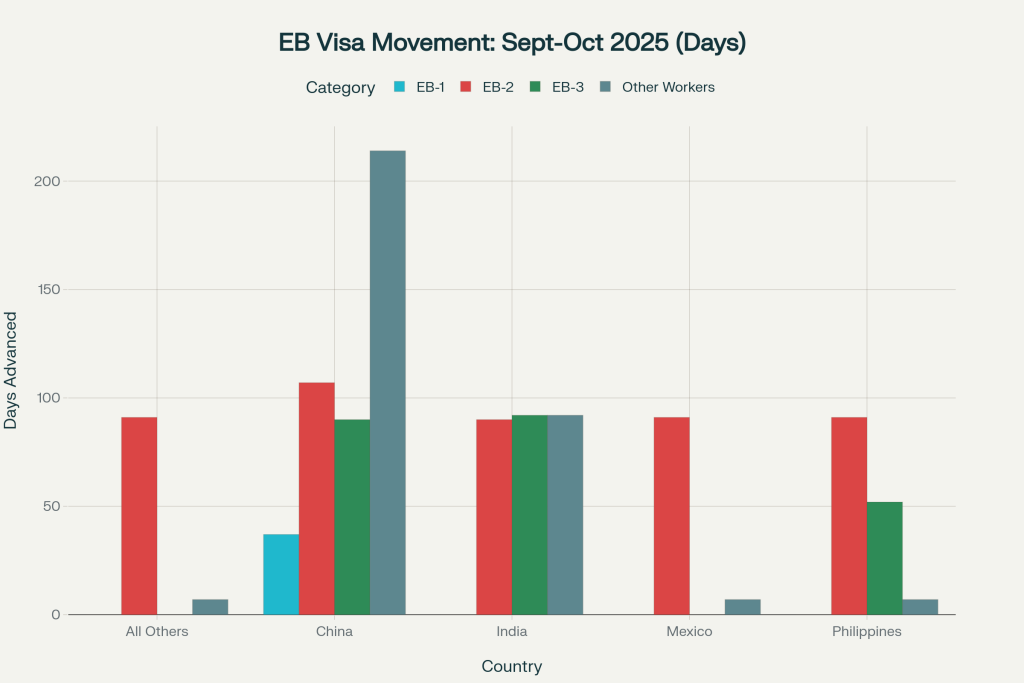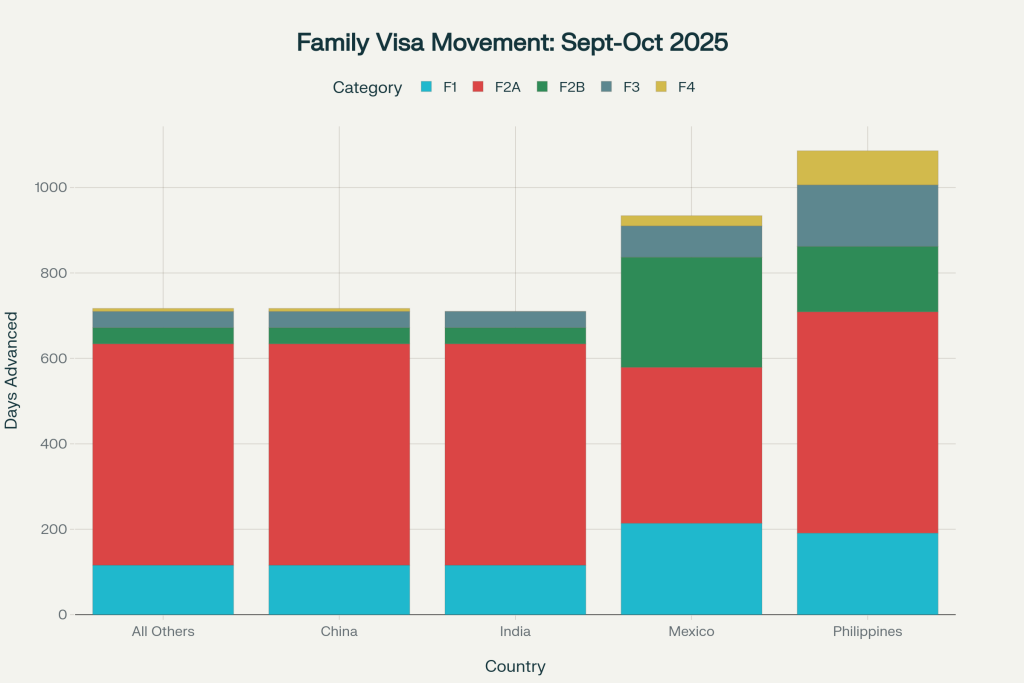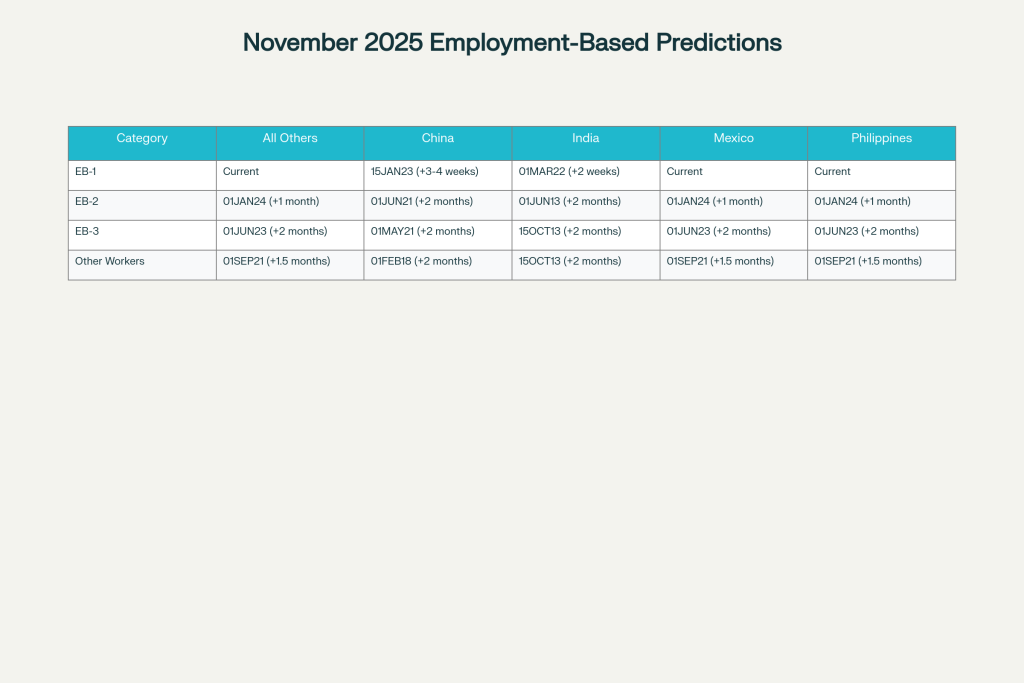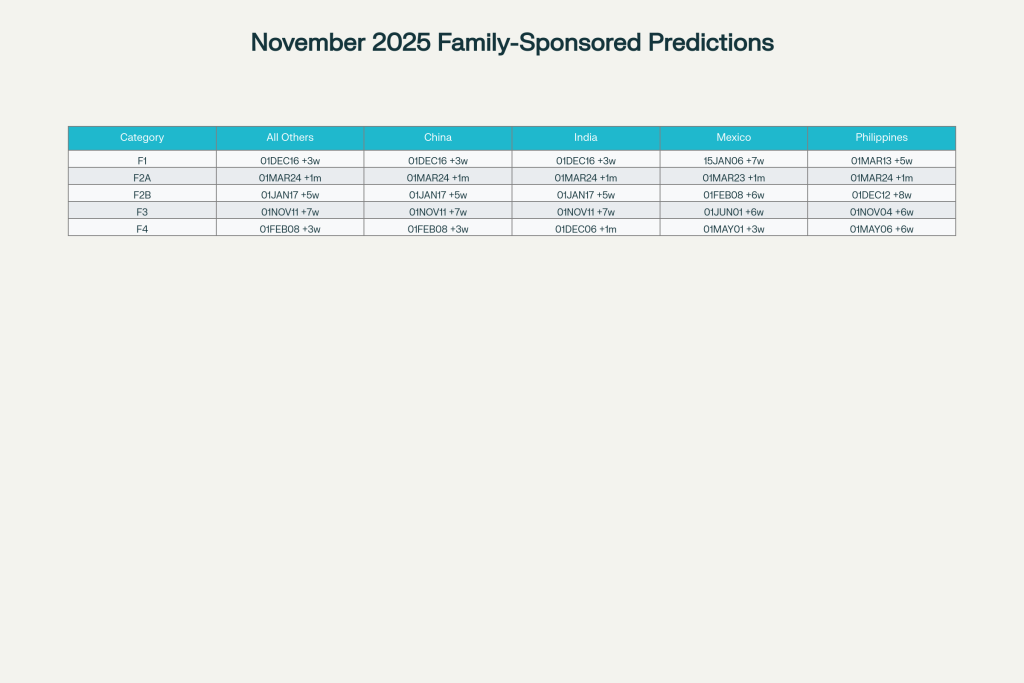The November 2025 Visa Bulletin is expected to continue the momentum established by the dramatic movements seen in October 2025, which marked the beginning of fiscal year 2026. Based on historical patterns, current trends, and the analysis of September and October 2025 bulletins, this comprehensive report provides detailed predictions for all visa categories, supported by quantitative analysis and historical precedent.
Executive Summary
November 2025 is positioned to deliver moderate but consistent advancement across most visa categories, following the substantial jumps witnessed in October 2025. Employment-based categories are expected to advance 1-2 months for most countries, while family-sponsored categories will likely see 3-8 weeks of forward movement. The new fiscal year’s visa allocation provides the foundation for continued progress, though per-country limits will continue to constrain advancement for India and China.
Employment-Based Category Predictions
EB-1 Priority Workers
The EB-1 category is expected to show minimal movement for most countries in November 2025, with notable exceptions for India and China. All other countries will likely remain current, maintaining the trend established throughout 2025.
Predicted Final Action Dates for November 2025:
- All Other Countries: Current (no change)
- China: January 15, 2023 (3-4 weeks advancement)
- India: March 1, 2022 (2 weeks advancement)
- Mexico: Current (no change)
- Philippines: Current (no change)
The limited movement in EB-1 reflects the category’s historical stability and the fact that it reached annual visa limits in early September 2025, with processing resuming only in October with the new fiscal year allocation.

EB-2 Advanced Degree Professionals
The EB-2 category demonstrated the most consistent advancement in the September-to-October transition, with all countries advancing approximately 90-107 days. This trend is expected to continue in November 2025 with steady 1-2 month progression.
Predicted Final Action Dates for November 2025:
- All Other Countries: January 1, 2024 (1 month advancement)
- China: June 1, 2021 (2 months advancement)
- India: June 1, 2013 (2 months advancement)
- Mexico: January 1, 2024 (1 month advancement)
- Philippines: January 1, 2024 (1 month advancement)
The robust movement in EB-2 is attributed to the fresh visa allocation for fiscal year 2026 and continued high demand processing by USCIS.
EB-3 Skilled Workers and Professionals
EB-3 categories are projected to maintain strong forward momentum established in October 2025, with most countries advancing 2 months. This category has shown particularly consistent movement patterns throughout 2025.
Predicted Final Action Dates for November 2025:
- All Other Countries: June 1, 2023 (2 months advancement)
- China: May 1, 2021 (2 months advancement)
- India: October 15, 2013 (2 months advancement)
- Mexico: June 1, 2023 (2 months advancement)
- Philippines: June 1, 2023 (2 months advancement)
Other Workers Category
The Other Workers category, which showed the most dramatic single advancement for China (214 days from September to October 2025), is expected to continue advancing at a steady pace of 1.5-2 months.
Predicted Final Action Dates for November 2025:
- All Other Countries: September 1, 2021 (1.5 months advancement)
- China: February 1, 2018 (2 months advancement)
- India: October 15, 2013 (2 months advancement)
- Mexico: September 1, 2021 (1.5 months advancement)
- Philippines: September 1, 2021 (1.5 months advancement)
Family-Sponsored Category Predictions
Family-sponsored categories experienced dramatic movements in October 2025, with F2A advancing over 500 days for most countries. November is expected to show more moderate but consistent advancement across all categories.

F1 – Unmarried Adult Children of US Citizens
The F1 category is predicted to advance 3-7 weeks in November 2025, with Mexico continuing to show the largest gains due to favorable per-country dynamics.
Predicted Final Action Dates for November 2025:
- All Other Countries: December 1, 2016 (3 weeks advancement)
- China: December 1, 2016 (3 weeks advancement)
- India: December 1, 2016 (3 weeks advancement)
- Mexico: January 15, 2006 (7 weeks advancement)
- Philippines: March 1, 2013 (5 weeks advancement)
F2A – Spouses and Children of Permanent Residents
F2A demonstrated the most spectacular advancement in October 2025, jumping over 500 days. November is expected to show continued but more modest 1-month advancement.
Predicted Final Action Dates for November 2025:
- All Other Countries: March 1, 2024 (1 month advancement)
- China: March 1, 2024 (1 month advancement)
- India: March 1, 2024 (1 month advancement)
- Mexico: March 1, 2023 (1 month advancement)
- Philippines: March 1, 2024 (1 month advancement)
F2B – Unmarried Adult Children of Permanent Residents
F2B is expected to advance 5-8 weeks, with the Philippines showing the strongest movement pattern.
Predicted Final Action Dates for November 2025:
- All Other Countries: January 1, 2017 (5 weeks advancement)
- China: January 1, 2017 (5 weeks advancement)
- India: January 1, 2017 (5 weeks advancement)
- Mexico: February 1, 2008 (6 weeks advancement)
- Philippines: December 1, 2012 (8 weeks advancement)
F3 – Married Children of US Citizens
F3 categories are projected to advance 6-7 weeks consistently across all countries.
Predicted Final Action Dates for November 2025:
- All Other Countries: November 1, 2011 (7 weeks advancement)
- China: November 1, 2011 (7 weeks advancement)
- India: November 1, 2011 (7 weeks advancement)
- Mexico: June 1, 2001 (6 weeks advancement)
- Philippines: November 1, 2004 (6 weeks advancement)
F4 – Siblings of US Citizens
F4 categories will likely show 3-6 weeks of advancement, with varying patterns by country.
Predicted Final Action Dates for November 2025:
- All Other Countries: February 1, 2008 (3 weeks advancement)
- China: February 1, 2008 (3 weeks advancement)
- India: December 1, 2006 (1 month advancement)
- Mexico: May 1, 2001 (3 weeks advancement)
- Philippines: May 1, 2006 (6 weeks advancement)


Special Categories and Diversity Visa Predictions
EB-4 Special Immigrants
The EB-4 category experienced significant disruption in 2025, becoming unavailable in April and remaining so through September due to annual limit exhaustion. With the start of fiscal year 2026, the category reopened in October 2025.
November 2025 EB-4 Predictions:
- Ministers: August 1, 2020 (1 month advancement from July 1, 2020)
- Non-Minister Religious Workers: Unavailable (sunset provision expired September 30, 2025)
The non-minister religious worker category remains unavailable due to the expiration of the sunset provision, which requires congressional reauthorization.
EB-5 Investor Categories
EB-5 categories are expected to continue steady advancement for China and India, while maintaining current status for other countries.
November 2025 EB-5 Predictions:
- Unreserved (China): February 1, 2016 (2 months advancement)
- Unreserved (India): April 1, 2021 (2 months advancement)
- Unreserved (All Others): Current
- Rural Set-Aside: Current (all countries)
- High Unemployment Set-Aside: Current (all countries)
- Infrastructure Set-Aside: Current (all countries)
Diversity Visa (DV-2026) Program
| Region | October_2025 | November_2025_Prediction | Change | Notes |
|---|---|---|---|---|
| Africa | 17500 | 17500 | No Change | Stable – high starting numbers |
| Asia | 10000 | 10000 | No Change | Stable – except Nepal (6000) |
| Europe | 7750 | 7750 | No Change | Stable – moderate demand |
| North America (Bahamas) | 20 | 20 | No Change | Stable – very limited |
| Oceania | 1100 | 1100 | No Change | Stable – gradual progression expected |
| South America & Caribbean | 1850 | 1850 | No Change | Stable – steady demand |
The DV-2026 program, which began processing in October 2025, is expected to maintain stable cut-off numbers in November 2025. The program started with relatively high cut-offs compared to previous years, suggesting conservative initial allocation.
November 2025 DV-2026 Predictions:
- Africa: 17,500 (no change)
- Asia: 10,000 (except Nepal: 6,000)
- Europe: 7,750 (no change)
- North America (Bahamas): 20 (no change)
- Oceania: 1,100 (no change)
- South America & Caribbean: 1,850 (no change)
The stability in DV cut-offs reflects the program’s conservative approach in early months, with more significant movement typically occurring in later months of the fiscal year.
Fiscal Year 2026 Impact Analysis
Numerical Limits and Allocations
Fiscal year 2026 brings fresh visa allocations that significantly impact November predictions. The employment-based limit is set at approximately 140,000 visas, with family-sponsored categories receiving 226,000 visas. Per-country limits remain at 7% of the combined total, approximately 25,620 visas per country.
Spillover Effects
The analysis of fiscal year 2025 data indicates approximately 20,000-25,000 unused family-based visas spilled over into employment-based categories. This spillover particularly benefits EB-1 categories and contributes to the robust advancement seen in October 2025.
Processing Patterns
USCIS processing data shows consistent month-over-month advancement in employment-based categories, with approximately 42,000 EB-1 green cards targeted for fiscal year 2025. The November 2025 bulletin is expected to reflect continued processing momentum.
Historical November Patterns
| Category | October_2025_Status | November_2025_Prediction | Expected_Change | Notes |
|---|---|---|---|---|
| EB-4 Ministers | 01JUL20 | 01AUG20 | 1 month advance | Gradual advancement expected |
| EB-4 Non-Ministers | Unavailable | Unavailable | Remains unavailable | Sunset provision expired Sep 30, 2025 |
| EB-5 Unreserved | Current/China: 08DEC15/India: 01FEB21 | Current/China: 01FEB16/India: 01APR21 | China: 2 months, India: 2 months | Continued steady advancement |
| EB-5 Rural | Current | Current | No change | Adequate supply |
| EB-5 High Unemployment | Current | Current | No change | Adequate supply |
| EB-5 Infrastructure | Current | Current | No change |
Movement Characteristics
Historical analysis of November visa bulletins reveals several consistent patterns:
- Moderate advancement: November typically shows 1-3 month advancement following October’s fiscal year reset
- Consistent progression: Employment-based categories tend to advance more predictably than family-based
- Country-specific variations: India and China continue to face per-country limit constraints
- End-of-year processing: USCIS often accelerates processing in November-December period
Comparison with Previous Years
November 2024 showed minimal movement across most categories, with status quo maintained from October. However, 2025’s pattern differs significantly due to the substantial October advancement, setting up November for continued momentum rather than stagnation.
Risk Factors and Uncertainties
Annual Limit Considerations
Several categories risk reaching annual limits during fiscal year 2026:
- EB-2: High demand may necessitate careful monitoring
- EB-3: Continued strong demand expected
- EB-5: India and China facing per-country constraints
Legislative Changes
The Religious Workforce Protection Act introduced in April 2025 could impact EB-4 processing if passed, though its effect on November 2025 predictions is minimal.
Processing Delays
USCIS processing capacity and embassy interview scheduling continue to influence actual advancement rates, potentially affecting predicted timelines.
Conclusion and Strategic Recommendations
November 2025 represents a pivotal month in the visa bulletin cycle, positioned between the dramatic October advancement and the traditionally slower winter months. The predictions indicate:
- Employment-based categories will maintain strong momentum with 1-2 month advancements
- Family-sponsored categories will show steady but moderate 3-8 week progression
- Special categories will face mixed outcomes due to legislative constraints
- Diversity visa processing will remain stable with gradual progression expected
Applicants should prepare for continued advancement while remaining aware of potential annual limit constraints later in fiscal year 2026. The November 2025 Visa Bulletin is expected to be published around October 13, 2025, providing official confirmation of these predictions.
The overall outlook for November 2025 remains optimistic, with the new fiscal year’s visa allocation providing the foundation for sustained advancement across most categories. However, per-country limits will continue to create disparities in advancement rates, particularly affecting applicants from India and China.













